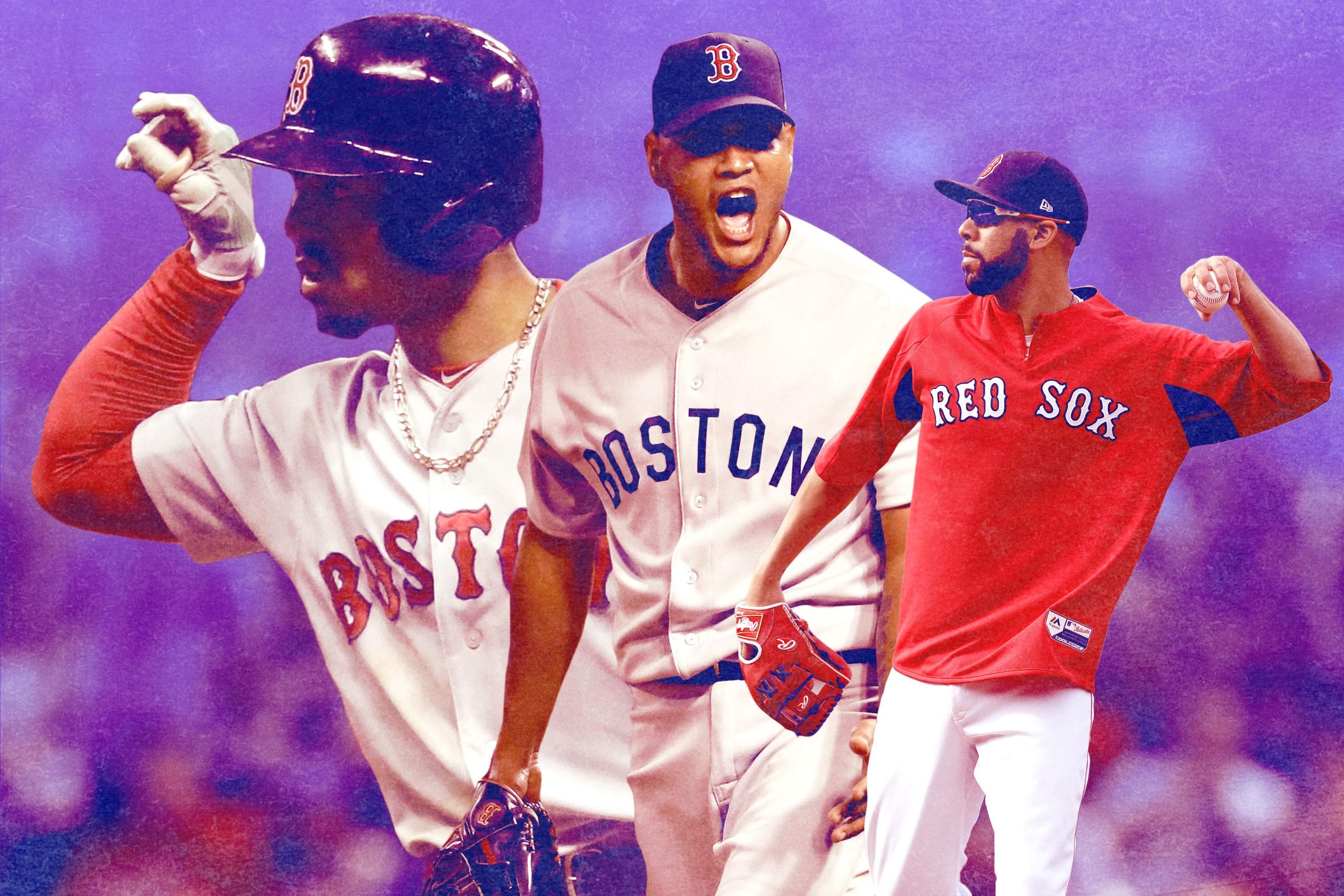
Saddle up, children, and don your favorite tricorn hat. It’s time to warn the American League: The Red Sox are coming! The Red Sox are coming! Take this message and ride, not to Lexington, but to Baltimore and Toronto, to New York and Tampa Bay. Gallop through downtown Cleveland and Houston’s wide city streets, and shout at the top of your patriotic, baseball-loving lungs that fear-mongering cry: The Red Sox are coming! The Red Sox are coming! And if someone asks how, respond:
One if by land and two if by sea?
No, they have three aces and four killer B’s.
Revere not the Pauls or the Papis of yore,
Instead, revere Sale, with strikeouts galore.
Eduardo’s electric, changeup in hand,
Porcello’s still great, if not a Cy man.
Pommy is palming the ball for strike threes,
And now Price is back; just stay healthy, please.
Betts, Beni, Bradley are roaming the grass,
They’ve suffered through slumps but will soon hit en masse.
Catcher’s a problem, third base a disaster,
So Double-A’s Devers might get called up faster.
Their issues are small, their talent immense;
The Sox will keep winning, that’s just common sense.

Please don’t actually ride a horse from Baltimore to Toronto and all the way to Houston. We have the internet for such cross-continental rabble-rousing nowadays. The point remains, though, that after a quarter-season of missing power, bad losses, and general malaise, the Red Sox are finally resembling the team that entered 2017 as a clear division favorite and the top presumptive challenger to Cleveland for the AL pennant. Boston won the East last year and added Chris Sale in the offseason; then David Price had an elbow scare, and when the season began the Sox couldn’t put together a winning streak. On Saturday, May 20, a middle-innings bullpen collapse yielded a third straight loss to Oakland, dropping Boston’s record to an underwhelming 21–21.
Then the bats woke up, and the Red Sox reeled off six consecutive wins to leap past the Orioles into second place in the AL East and first place in the early wild-card standings. After losing to the White Sox in David Price’s return to the MLB mound Monday, Boston sits at 27–23, three games back of the Yankees for first place in the East.
The most notable feature of the resurgent Red Sox is their offensive revival. In April, Boston hit a league-low 15 home runs and scored the 25th-most runs; thus far in May, the team has hit 27 homers and tied for the fifth-most runs. A handful of extreme run totals — they scored 17 on May 7, then 12 and 11 in consecutive games immediately following that third Oakland loss — spurs that difference, but so does an avoidance of empty games: In April, the Red Sox scored zero or one runs in a game six times, but they’ve done so just once in May. There was never any reason to worry about the Sox’s offense, and there still isn’t, despite the presence of two adjoining black holes at the bottom of the lineup.

Shortstop Xander Bogaerts is the only everyday player whose underlying numbers (a .388 BABIP paired with a slap hitter’s ground ball rate) suggest he’s due for negative regression. Meanwhile, the outfield alone could house a trio of improvements, as rookie left fielder Andrew Benintendi has yet to break out, right fielder Mookie Betts has an uncharacteristically low BABIP, and, as MLB.com’s Mike Petriello noted last week, center fielder Jackie Bradley Jr.’s poor results belie the reality that he’s hitting the ball well; his numbers indeed have been ticking back up of late.
The two problem positions are catcher and third base. At the former, Sandy León has failed to recapture the magic his bat enjoyed last summer; since the start of September 2016, he has a 60 wRC+ in 187 plate appearances. Christian Vázquez has played more with León struggling, but nothing about his hitting profile suggests his current .345/.378/.464 slash line is sustainable.
Teams can survive without production from their backstops, though, and with Vázquez rating as an elite pitch framer, the Red Sox will take whatever offense he can add. Third base is more precarious, with Boston’s options there combining for the second-fewest WAR of any such group in the majors. Pablo Sandoval was bad before he got hurt, and the melange of replacement-level fill-ins has underwhelmed. Five Red Sox have appeared at third base this year; the best wRC+ among the group belongs to Josh Rutledge, who doesn’t have an extra-base hit in 54 plate appearances. The developing trade market for third basemen appears thin, but the best potential solution is already in-house.
Rafael Devers is a universal top-20 prospect, and, at 20 years old, he was the second-youngest player to start the year in the Double-A Eastern League. The age gap hasn’t slowed his progress, though, as he’s posted a .288/.353/.506 slash line in his first 42 games at that level. Devers is young and inexperienced in the high minors, but as the recent trajectories of Bradley, Betts, and the since-traded Yoan Moncada show, the Sox aren’t averse to fast-tracking their top hitting prospects. It wouldn’t be a surprise to see Devers manning third base in Boston sometime before July, which would allow the organization to see whether he’s ready now or if it needs to make a trade-deadline upgrade. His predecessors’ mixed results upon first introduction to the major leagues — Bradley yo-yoed between Triple-A Pawtucket and Boston for three seasons, and Moncada struck out 12 times in 20 plate appearances — warn that a 20-year-old Devers is no sure thing, but even a modest performance would be a vast improvement over the likes of Rutledge and Deven Marrero.
Devers’s potential promotion might solve Boston’s biggest run-production problem; David Price’s return from offseason elbow stiffness should address the team’s biggest run-prevention issue. This season Boston’s rotation has contributed 5.7 WAR, tied for second most in the majors. That standing is skewed by the singular Chris Sale, who’s been worth 3.2 wins in one of the most dominant starting campaigns in MLB history, but it’s also warped in the other direction by Boston’s fifth starters, who before Price pitched on Monday had combined for a 7.71 ERA.
Price looked sharp against the White Sox in his first start of the season, striking out four and allowing only four base runners in five innings. His fastball hit its typical mph marks, his breaking balls showed bite, and save one mistake — a hanger that Melky Cabrera crushed for a three-run homer — he limited hard contact throughout. The organization will remain on alert regarding Price’s health for the rest of the season, but if he stays fit, his addition gives Boston the majors’ best rotation east of Dodger Stadium.

One hundred and twenty-two starters have thrown at least 40 innings this year, and Boston places four among the top 30 in strikeout-minus-walk ratio. Sale has been impressive enough that baseball observers have at least floated the "Sale or Kershaw?" question, and Drew Pomeranz has allowed two or fewer runs in seven of nine starts. Rick Porcello seems like a relative disappointment following last season’s Cy Young campaign, but other than a minor homer surge, his rate stats are in line with those from last year. The difference in the perception of Porcello’s seasons emerges from two sets of numbers: his win-loss record (his six losses already surpass the four he totaled last year) and his ERA, which is more than a run higher in 2017 because Porcello has the highest BABIP allowed of any qualified starter in the majors — a string of misfortune that’s bound to reverse course.
Then there’s Eduardo Rodríguez, the final hard-throwing lefty in a rotation full of them. Rodríguez had never managed consistent success in his first two seasons at the MLB level, but this year he has boosted his strikeout rate, cut his ERA from 4.71 last year to 2.77, and turned seven quality starts in a row by reducing usage of his slider, his worst pitch, and tightening the command of his changeup, his best offering and the seventh most valuable in the majors this year. Before this year, while he tried to keep his change confined to the bottom corner of the strike zone, it had a tendency to leak back over the plate, which allowed hitters to square up the ball and return it with power. A map of the hits he allowed off his changeup in 2015 and 2016 exhibits this phenomenon:

In 2017, though, Rodríguez has hit his spot more often, and when he has missed that target, he’s done so either low or farther outside — avoiding the dreaded "middle-middle" location. Here’s the same map for this season, and though the sample is still small, it’s revealing that all these dots are on the edge of the strike zone.

The overall picture is even prettier. Per Brooks Baseball’s tabulations, before this year, Rodríguez had generated whiffs on 33 percent of swings against his changeup and allowed seven homers with a 25 percent strikeout rate on 182 at-bats ending with the pitch. This season, he’s upped his whiff rate to 43 percent and his strikeout rate to 39 percent, and he has yet to allow a home run in 44 at-bats ending with the change. Because a changeup is most effective against opposite-handed batters, it makes sense that righty hitters have struggled against Rodríguez more than they have against almost any other southpaw.
Rodríguez’s leap reflects the most encouraging attribute of this Boston team: a surfeit of talent, as so many different Red Sox either already are stars or have the potential to become one, which is about the best fail-safe against an extended team-wide slump. Having trouble with rotation depth? Plug in a former Cy Young winner who’s been worth at least four WAR every year since 2010. Suffering from empty at-bats at the hot corner? Call up the best third-base prospect in the game. Worried about a lack of offensive punch? Just wait for a lineup populated with All-Stars to start producing like they have throughout their careers. The Red Sox are coming, and in an AL East landscape that once again looks like the best in baseball, they’re still the favorites to wear the divisional crown.

